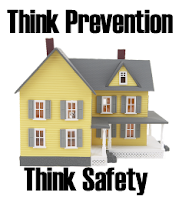 |
| Handle All Produce Properly Before Consumption |
When was the last time you came home from the produce market and put the melon on the kitchen counter along with the other produce items that you take out of your bags? Well this is what you and a million others do on the regular.
Have you given any thought to the germs and pesticides that came home with you? Just in case you haven't entertained this thought now is a good time to start thinking about this and don't stop there act on this, become accountable to yourself and your loved ones.
One of the first things I do when I get in from grocery shopping and put my bags down is wash my hands. A good rule of thumb is to use hot soapy water and sing happy birthday before rinsing. Yeah, I know this may sound pretty juvenile but guess what, some nursing schools have taught this to their first year nursing students.
Do you think about where your fruit and vegetables are grown? Be it your local farms, Mexico or other countries. Have you wondered about the content of the soil? Maybe you’ve pondered what types of pesticides were used if you didn’t purchase organic fruits and vegetables.
These are all reasons to show concern and to become diligent seekers educating ourselves and asking our legislators to step in and propose bills that will ensure better health & safety codes for pesticides used for agriculture.

Pesticides
Let's take a look at pesticides for a moment, here is a list I am sure you will find a bit alarming. Based on information and studies by the United States Department of Agriculture (USDA), Consumer Reports, and the Environmental Working Group, the fruits and vegetables in this list have been found to contain the most amounts of pesticides.- Nectarines – 97.3% of nectarines sampled were found to contain pesticides.
- Celery – 94.5% of celery sampled were found to contain pesticides.
- Pears – 94.4% of pears sampled were found to contain pesticides.
- Peaches – 93.7% of peaches sampled were found to contain pesticides.
- Apples – 91% of apples sampled were found to contain pesticides.
- Cherries – 91% of cherries sampled were found to contain pesticides.
- Strawberries – 90% of strawberries sampled were found to contain pesticides.
- Imported Grapes – 86% of imported grapes (i.e. Chile) sampled were found to contain pesticides.
- Spinach – 83.4% of spinach sampled were found to contain pesticides.
- Potatoes – 79.3% of potatoes sampled were found to contain pesticides.
- Bell Peppers – 68% of bell peppers sampled were found to contain pesticides.
- Red Raspberries – 59% of red raspberries sampled were found to contain pesticides.
 |
| Knowing how to clean properly is key |
- Asparagus
- Avocados
- Bananas
- Broccoli
- Cauliflower
- Corn (almost all corn is genetically modified or GMO)
- Kiwi
- Mangoes
- Onions
- Papaya
- Pineapples
- Sweet Peas
- Any of the large or medium melons
Safety Tips
Here are some helpful hints to assure better safety for you and your loved ones:- Wash your hands with hot soapy water before and after preparing food.
- Clean your counter top, cutting boards and utensils after peeling produce and before cutting or chopping. Bacteria from the outside of raw produce can be transferred to the inside when it is cut or peeled. Wash kitchen surfaces and utensils with hot, soapy water after preparing each food item.
- For produce with thick skin, use a vegetable brush to help wash away hard-to-remove chemicals.
- Produce with a lot of nooks and crannies like cauliflower, broccoli or greens, cabbage & lettuce should be soaked for 1 to 2 minutes in cold distilled water.
- I would not recommend soaking raspberries, blackberries or strawberries in water because they are just too fragile.
- Place these delicate fruits in a colander and spray them with distilled water.
- After washing, I lay them out on a dry clean paper towel.
- There are many times I will pick up a small apple or tangerine while on the go and it has become a practice for me to fill a biodegradable spray bottle with distilled water and keep in my car, avoid the temptation of sampling produce in the store without properly washing before eating.
- Do not rewash packaged products labeled “ready-to-eat,” “washed” or “triple washed.”
- Once you cut or peel any produce refrigerate as soon as possible at 40ºF or below.
- It is not a safe practice to purchase cut produce that is not refrigerated.
More options to consider
Use of distilled water, white vinegar, fresh squeezed lemon and baking soda are also effective ways to reduce the amount of chemicals found on our produce. |
| Wash even thick hard skinned |
Bear in mind produce such as apples and colorful peppers have the heaviest wax coatings. This increases the likelihood of pesticide residues residing beneath that wax coating which require the use of a brush or some type of cleansing agent that will remove the wax and ultimately the residue. Mushrooms are highly porous and will absorb and retain the taste of Veggie Wash so for this reason it is not recommended.
Please note that most non-organic produce contain residual pesticides even after washing. One practice I continually follow, is blessing my food before consuming.
Terrye











